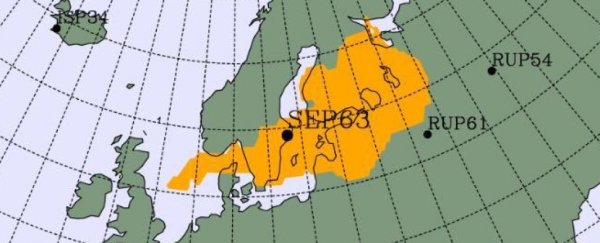A mysterious increase in radiation levels over northern Europe was detected this month by authorities from several countries, although no nation has yet come forward to claim responsibility for the anomaly.
The subtle radiation spike – at levels that are considered harmless to humans, but significant enough to be picked up by radiation monitoring stations – began to make headlines last week, with European authorities announcing new readings of human-made radionuclide particles in the atmosphere.
"Very low levels of the radioactive substances cesium-134, cesium-137, cobalt-60 and ruthenium-103 were measured," the Swedish Radiation Safety Authority tweeted on Tuesday.
"The levels measured are so low that they pose no danger to people or the environment."
Similar observations were also made by radiation protection authorities in Norway and Finland.
Later in the week, Lassina Zerbo, the Executive Secretary of the Comprehensive Nuclear-Test-Ban Treaty Organisation, tweeted a map outlining the possible source region of the anomaly, most of which was territory inside Russia, but also parts of Finland, Sweden, Denmark, and Norway.
22 /23 June 2020, RN #IMS station SEP63 #Sweden🇸🇪 detected 3isotopes; Cs-134, Cs-137 & Ru-103 associated w/Nuclear fission @ higher[ ] than usual levels (but not harmful for human health). The possible source region in the 72h preceding detection is shown in orange on the map. pic.twitter.com/ZeGsJa21TN
— Lassina Zerbo (@SinaZerbo) June 26, 2020
"These isotopes are most likely from a civil source," Zerbo tweeted, suggesting a source related to nuclear power production, not nuclear weapons.
"We are able to indicate the likely region of the source, but it's outside the CTBTO's [Comprehensive Nuclear-Test-Ban Treaty Organization] mandate to identify the exact origin."
On Friday, the Dutch National Institute for Public Health and the Environment (RIVM) announced that, based on an analysis of the available data, the "combination of radionuclides may be explained by an anomaly in the fuel elements of a nuclear power plant".
On the available evidence, the organisation suggested that the radioactive particles detected had come from the direction of western Russia, but clarified that this did not mean they were definitively linked with Russian power plants.
"Some recent media reports claimed, possibly based on a mistranslation of our original report (in Dutch), that the radionuclides originated from western Russia," RIVM said in a statement.
"The claim RIVM makes is that the radionuclides travelled from the direction of western Russia to Scandinavia, but that no specific country of origin can be pointed out at this moment."
In response to online speculation that Russia was behind the radiation spike, a spokesperson for Rosenergoatom, part of Rosatom state nuclear energy corporation, said the nation's two nuclear power plants in the region were operating normally, with normal radiation levels being reported.
"Both stations are working in normal regime. There have been no complaints about the equipment's work," Rosenergoatom told Russian news agency TASS.
"Aggregated emissions of all specified isotopes in the above-mentioned period did not exceed the reference numbers. No incidents related to release of radionuclide outside containment structures have been reported."
As it stands, it's hard to say whether additional evidence will be able to confirm where this slight radiation surge originated, but the incident recalls a similar situation that took place in 2017, in which another radioactive cloud was detected over Europe.
During that episode – which was also detected at levels harmless to people – many suggested Russian power plants were responsible – a hypothesis that was later supported by scientific findings, although disputed by Rosatom.
